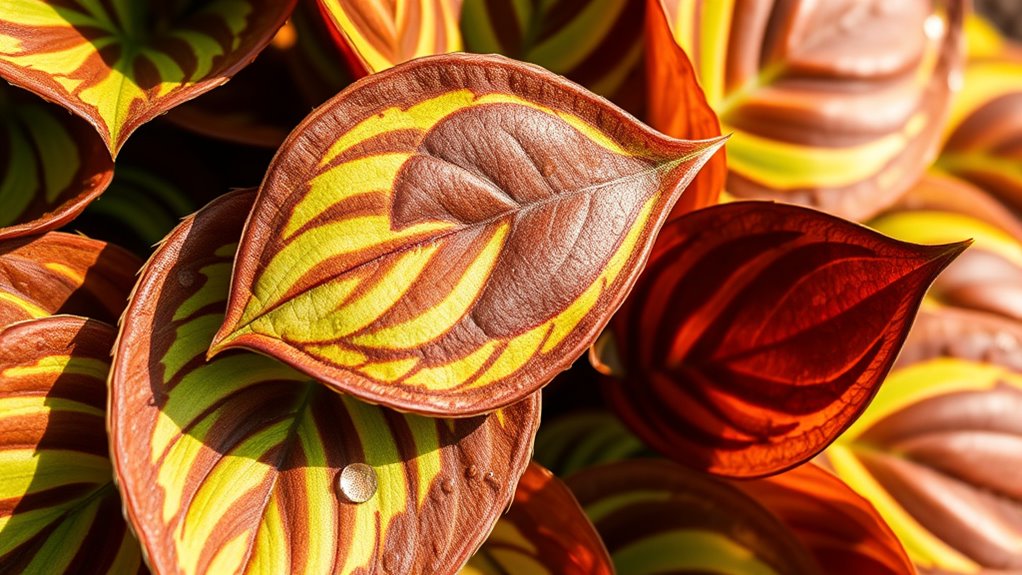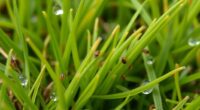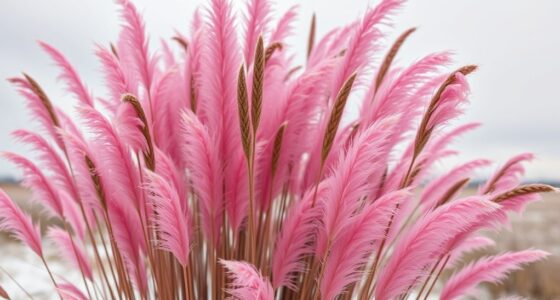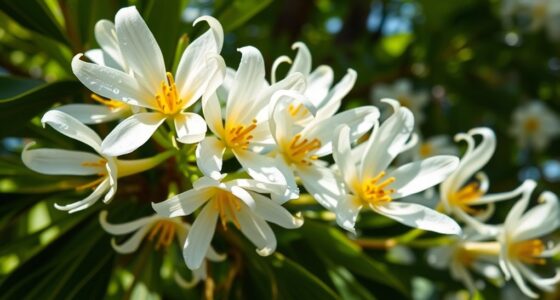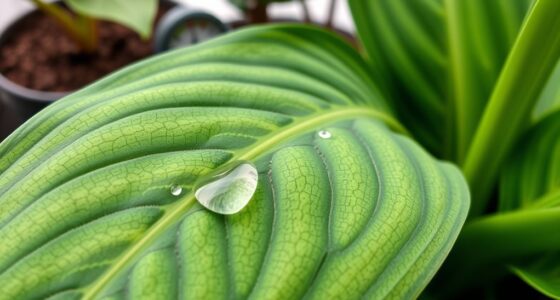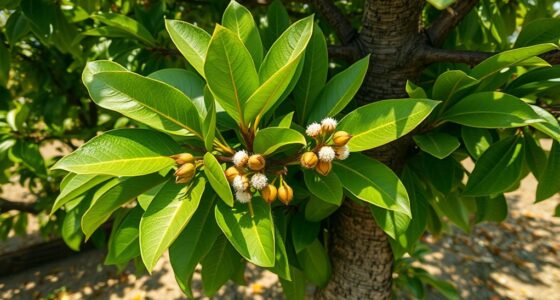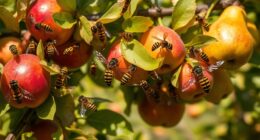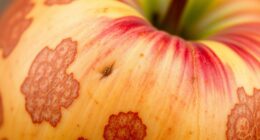If your Tradescantia Nanouk has brown leaves, check your watering habits first. Water only when the top inch of soil feels dry, and make sure your pot drains well to prevent root rot. Also, give your plant bright, indirect light, avoiding direct sun that can scorch the leaves. Proper watering and lighting are key. Stay tuned for more tips to keep your Nanouk healthy and vibrant!
Key Takeaways
- Ensure the soil drains well and avoid waterlogging by using pots with proper drainage holes.
- Water only when the top inch of soil is dry to prevent overwatering and root rot.
- Provide bright, indirect light, avoiding direct sun that can scorch leaves and cause browning.
- Increase humidity with pebble trays or humidifiers to prevent leaf tips from drying out.
- Regularly monitor leaves for signs of stress and adjust watering and lighting routines accordingly.
Recognizing the Causes of Brown Leaves in Nanouk
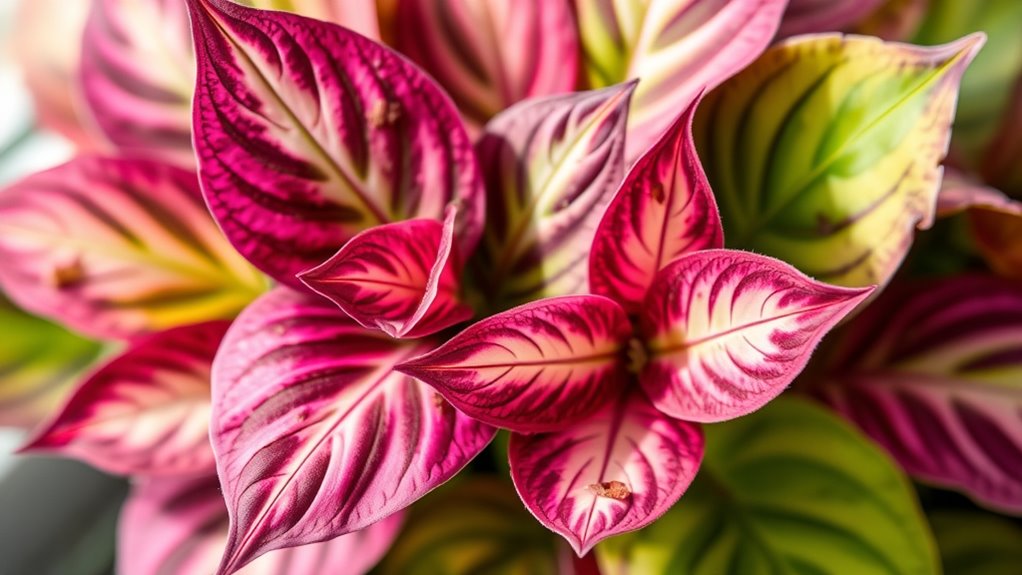
Brown leaves on your Tradescantia Nanouk often signal underlying issues that need your attention. Poor soil drainage can cause water to sit around the roots, leading to root rot and browning tips. Check if your pot has adequate drainage holes and avoid overwatering. Additionally, humidity levels play a significant role; low humidity can cause leaf tips to dry out and turn brown. If your environment is dry, consider increasing humidity with a pebble tray or humidifier. Keep an eye on these factors to identify the root cause of browning leaves. By ensuring your Nanouk’s soil drains well and maintaining proper humidity, you can prevent browning and promote healthy, vibrant foliage. Proper watering practices are essential for preventing issues related to overwatering and root health. Addressing these issues early helps your plant stay lush and lively.
Adjusting Your Watering Habits for Better Plant Health

To keep your Tradescantia Nanouk healthy, start by checking the soil moisture regularly. Water only when the topsoil feels dry to prevent overwatering, which can cause brown or mushy leaves. Keeping a balanced watering routine helps your plant stay vibrant and avoids unnecessary stress. Using a moisture meter can assist in accurately assessing soil water content and ensuring optimal watering levels.
Monitor Soil Moisture
Monitoring soil moisture is essential for maintaining the health of your Tradescantia Nanouk. Check the soil regularly by sticking your finger about an inch deep; if it feels dry, it’s time to water. Proper soil drainage is key—water shouldn’t pool or sit on the surface, as excess moisture can cause root rot. Keep an eye on humidity levels too, since high humidity helps retain moisture but too much can promote fungal issues. Use a moisture meter for more accuracy if needed. Adjust your watering schedule based on these readings, ensuring the soil stays evenly moist but not waterlogged. Additionally, understanding soil composition helps optimize watering practices and promotes healthy root development. Consistently monitoring soil moisture helps you prevent overwatering or underwatering, keeping your Nanouk vibrant and healthy.
Water When Topsoil Dries
Wondering when to water your Tradescantia Nanouk? The best approach is to wait until the topsoil dries out completely before watering again. This prevents water from sitting in the soil, which can cause root rot. Check the soil’s moisture level regularly by touching the surface; if it feels dry, it’s time to water. Good soil drainage is essential to avoid excess water retention, so ensure your pot has drainage holes. Additionally, humidity levels influence how often you need to water; higher humidity can reduce the frequency. By adjusting your watering habits to the dryness of the soil, you promote healthy roots and vibrant leaves. Remember, watering only when the topsoil dries helps maintain the right balance for your Tradescantia Nanouk’s growth.
Avoid Overwatering Risks
Overwatering is one of the most common mistakes that can harm your Tradescantia Nanouk, so it’s essential to adjust your watering habits accordingly. To prevent overwatering, focus on proper repotting techniques by choosing well-draining soil and pots with drainage holes. This helps excess water escape and reduces root rot risks. When watering, wait until the topsoil feels dry before watering again, and avoid frequent watering schedules. Additionally, select fertilizer choices carefully; too much fertilizer can encourage overgrowth and water retention. Use a balanced, diluted fertilizer during the growing season, but don’t overdo it. Monitoring soil moisture and adjusting your watering routine accordingly will keep your Nanouk healthy and vibrant, avoiding the dangers of overwatering. Understanding self watering plant pots can also help maintain consistent moisture levels without overdoing it. Incorporating humidity levels into your plant care routine can further promote healthy growth and reduce stress caused by inconsistent watering.
Optimizing Light Conditions to Prevent Leaf Browning

To prevent leaf browning on your Tradescantia Nanouk, it’s essential to optimize its light conditions. Ensure it receives bright, indirect sunlight, which encourages healthy growth without scorching the leaves. Proper soil aeration plays a vital role, as compacted soil can hinder nutrient uptake and cause stress, leading to browning. Adjust your fertilizer frequency to support consistent, balanced nutrition—over-fertilizing can stress the plant, while under-fertilizing limits its resilience. Position your plant near a sheer curtain or a few feet from a window to diffuse harsh rays. Regularly check that the soil remains well-drained and airy. Ensuring your plant is compatible with Bluetooth headsets allows for seamless audio experiences when using it for background music or relaxation. Good soil aeration helps prevent issues related to compacted soil, promoting healthier roots and foliage. Additionally, selecting appropriate lighting conditions can significantly reduce stress on the plant and improve its overall vitality. By maintaining ideal light, soil aeration, and appropriate fertilization, you reduce the risk of leaf browning and promote vibrant, healthy foliage.
Signs of Overwatering and Underwatering to Watch For

Recognizing the signs of overwatering and underwatering is essential for maintaining your Tradescantia Nanouk’s health. If your plant shows yellowing or dull leaf color, it could indicate overwatering, which often leads to root rot and poor root health. Conversely, if the leaves become crispy, brown at the edges, or droop, it’s a sign of underwatering, causing the plant to conserve moisture. Overwatered plants may also develop soft, mushy stems or leaves, while underwatered ones tend to have dry, brittle foliage. Monitoring these symptoms helps you adjust your watering routine promptly, ensuring the roots stay healthy and the plant remains vibrant. Proper watering prevents stress and supports the Nanouk’s overall growth and resilience. Additionally, adjusting watering habits based on plant hydration needs can significantly improve your plant’s health and longevity. Paying attention to watering frequency and observing how quickly the soil dries out can help refine your watering routine for optimal plant care.
Choosing the Right Lighting Setup for Vibrant Foliage
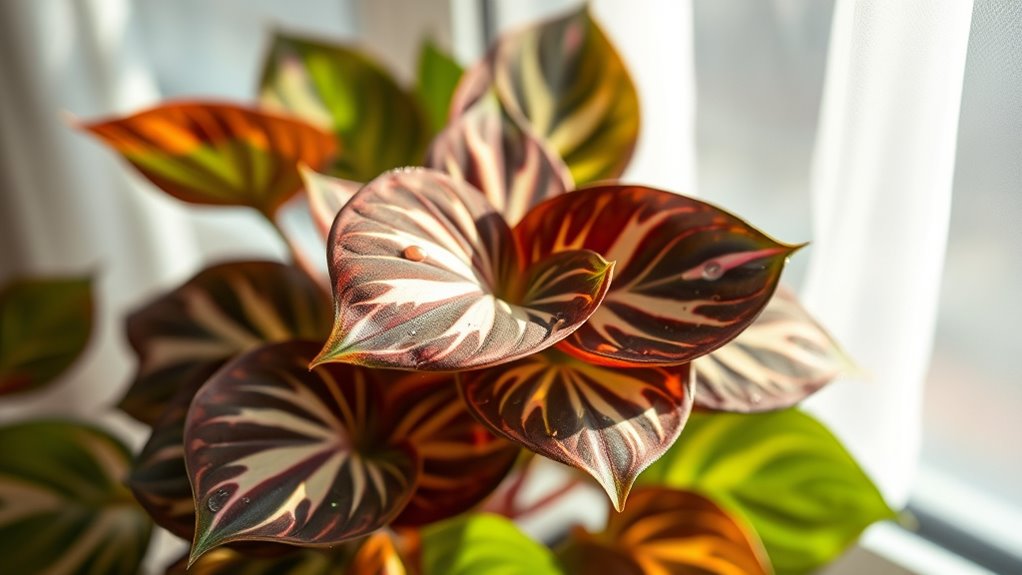
To keep your Tradescantia Nanouk’s leaves vibrant, place it where it gets bright, indirect light. Direct sunlight can scorch its delicate foliage and cause brown patches. Find a spot that offers gentle, filtered light for the best results. Using the right lighting setup can significantly enhance the plant’s color and health.
Bright Indirect Light
Bright, indirect light is essential for Tradescantia Nanouk to develop its vibrant, colorful foliage. Placing your plant near a window with filtered sunlight ensures it gets enough light without risking leaf scorch. To support healthy growth, make sure the soil has good drainage so excess water doesn’t lead to root rot. Maintaining proper humidity control also helps the plant thrive, especially in dry indoor environments. High humidity levels keep the leaves lush and prevent browning tips. If natural light is limited, consider using grow lights to supplement. Remember, consistent, bright indirect light encourages the rich pinks, purples, and greens that make Nanouk so striking, while proper soil drainage and humidity create the ideal environment for excellent foliage development. Additionally, choosing the right lighting setup for vibrant foliage can significantly enhance the plant’s coloration and overall health. Ensuring your lighting setup aligns with keto-friendly ingredients can optimize both plant health and dietary goals.
Avoid Direct Sunlight
While Tradescantia Nanouk thrives in bright, indirect light, exposing it to direct sunlight can cause leaf scorch and fading colors. To protect your plant, place it where sunlight filters through curtains or use sheer blinds. Direct sunlight can also dry out the soil quickly, so make sure your soil drainage is excellent to prevent waterlogging or root rot. Maintaining proper humidity levels helps keep the foliage healthy and vibrant. If the air is too dry, your Nanouk may develop brown leaf edges, so consider misting or using a humidifier. Avoid harsh, direct rays that can stress the plant, leading to faded colors and damaged leaves. Instead, provide consistent, indirect light to keep your Nanouk lively and colorful. Additionally, understanding the plant’s vital light requirements can help optimize its growth and appearance. Recognizing the importance of light quality ensures your Tradescantia Nanouk remains healthy and vibrant.
Implementing Proper Watering and Lighting Routines
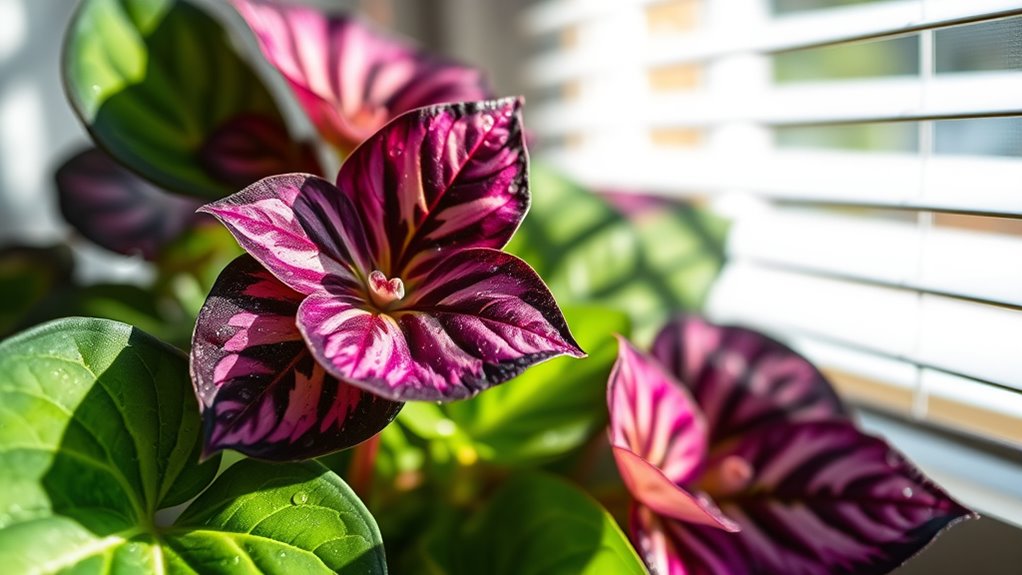
Ensuring your Tradescantia Nanouk maintains vibrant brown leaves requires establishing consistent watering and lighting routines. Start by watering only when the top inch of soil feels dry, avoiding overwatering that can suffocate roots. Proper soil aeration is key—use well-draining soil and occasional gentle mixing to prevent compaction. Place your plant in bright, indirect light to encourage healthy growth, but avoid direct sun that can scorch leaves. Stick to a fertilization schedule of balanced liquid fertilizer every 4-6 weeks during the growing season to supply essential nutrients. Regularly adjusting watering based on seasonal changes and ensuring proper soil aeration will promote stronger roots and vibrant foliage. Consistency is essential for preventing brown leaf issues and maintaining your Nanouk’s health. Incorporating aspects of plant health maintenance, such as monitoring humidity levels and soil quality, can further support your plant’s well-being. Additionally, being aware of angel number guidance related to love and relationships can foster a positive mindset that benefits your overall well-being, including your care routines.
Monitoring Your Nanouk’s Progress and Making Further Adjustments
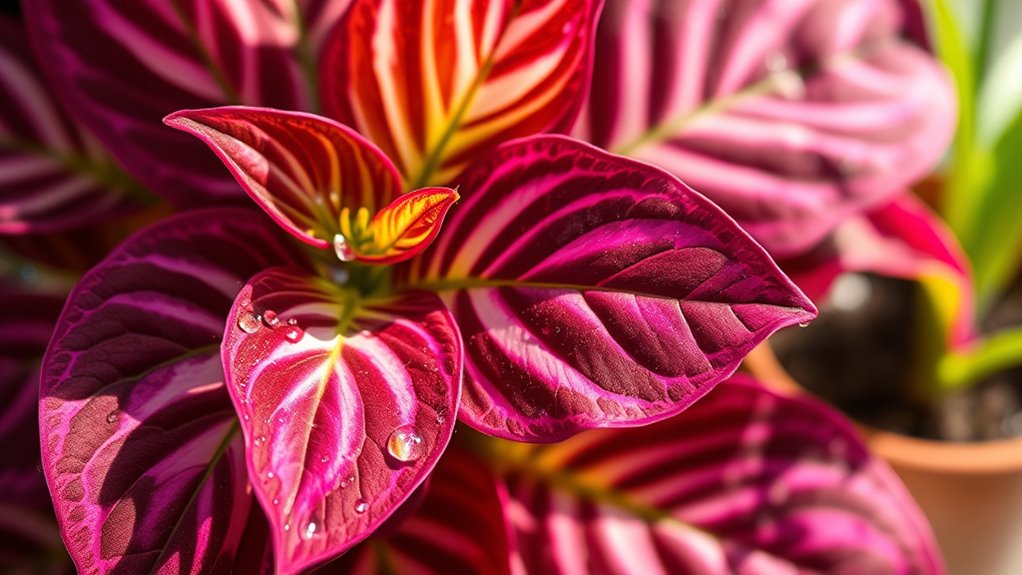
Monitoring your Nanouk’s progress is essential to catch any issues early and guarantee it stays healthy. Regular growth monitoring helps you notice changes in size, leaf color, and overall vigor. Keep an eye on leaf health, looking for signs of browning, wilting, or spots that indicate stress or deficiencies. If you notice your Nanouk isn’t growing as expected or leaves are browning, it’s time to make adjustments. Ensure it’s receiving adequate light and proper watering. Take notes on its development to identify patterns or recurring problems. Proper watering techniques are crucial for preventing issues like root rot or dehydration. Additionally, maintaining appropriate light levels supports healthy photosynthesis and growth. By staying attentive, you can fine-tune your care routine, providing the right environment for vibrant, healthy growth. Consistent monitoring allows you to react promptly and maintain your Nanouk’s beautiful appearance.
Frequently Asked Questions
How Often Should I Prune My Tradescantia Nanouk to Prevent Browning?
You should prune your Tradescantia Nanouk every 2-4 weeks to prevent browning and keep it healthy. Regular pruning encourages new growth and removes dead or damaged leaves, which helps prevent browning. Keep an eye on the plant’s condition, and prune more often if you notice browning or leggy stems. Consistent pruning is key to browning prevention and maintaining a vibrant, lush appearance.
Can Fertilizer Deficiencies Cause Brown Leaves in Nanouk?
Imagine your Nanouk’s vibrant leaves fading to brown like autumn leaves—that’s often caused by fertilizer issues. Nutrient deficiencies from inadequate fertilization can weaken the plant, leading to brown, crispy edges. If you neglect proper feeding, your plant misses essential nutrients, causing stress and discoloration. To prevent this, make certain you’re providing balanced fertilization, avoiding deficiencies that turn lush green leaves into a browning spectacle. Regular feeding keeps your Nanouk lively and healthy.
What Temperature Range Is Ideal for Nanouk’s Health?
You should keep your Nanouk’s temperature between 65-75°F to guarantee its health. Maintaining proper humidity levels and temperature regulation helps prevent stress that can lead to brown leaves. Avoid sudden temperature changes or drafts, as these can harm your plant. Consistent warmth and humidity support vibrant growth. If your home is dry, consider misting or using a humidifier to keep humidity levels appropriate, guaranteeing your Nanouk thrives.
Are There Specific Humidity Levels That Reduce Leaf Browning?
To reduce leaf browning, maintaining proper humidity control is crucial. You should aim for humidity levels around 40-60%, which helps keep Nanouk’s leaves healthy. Misting techniques can boost humidity, but avoid overdoing it to prevent fungal issues. Regular misting or placing a humidifier nearby ensures consistent moisture in the air, supporting your plant’s vitality and preventing those unsightly brown leaves.
How Can I Tell if Pests Are Causing My Nanouk’s Brown Leaves?
To tell if pests are causing your Nanouk’s brown leaves, look for pest identification and leaf damage signs. Check the undersides of leaves, stems, and soil for tiny insects like spider mites, aphids, or mealybugs. Look for sticky residue, webbing, or small holes. If you notice these signs, it’s likely pests. Act quickly by isolating your plant and applying targeted treatments to prevent further damage.
Conclusion
By adjusting your watering and lighting habits, you can considerably reduce brown leaves on your Tradescantia Nanouk. Did you know that improper watering is a leading cause of leaf browning, affecting up to 60% of houseplants? Staying attentive to your plant’s needs and making small routine changes can boost its health and vibrancy. With consistent care, your Nanouk will thrive, showcasing its beautiful, lush foliage for years to come.
